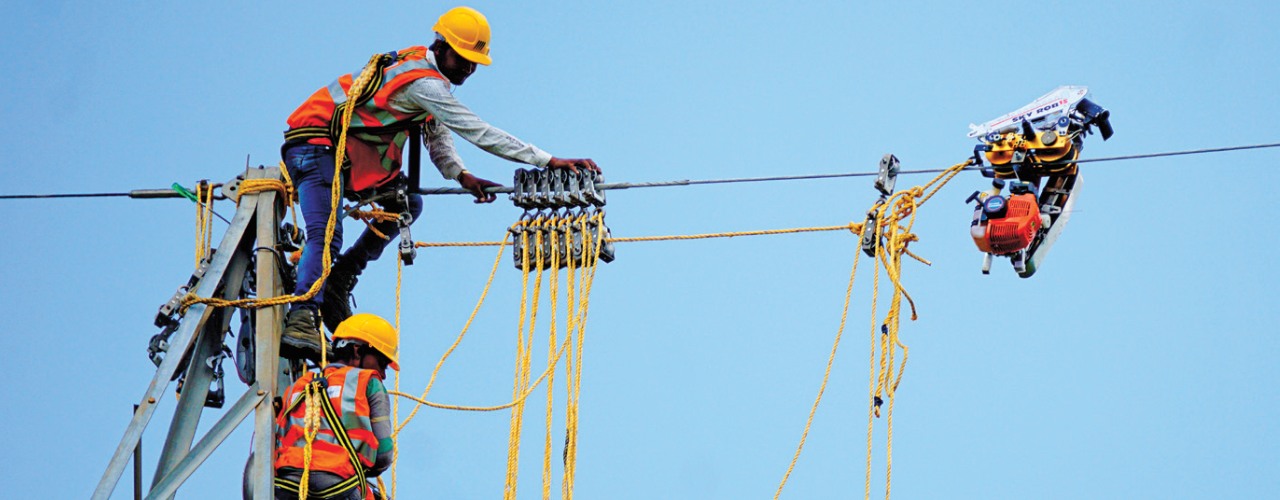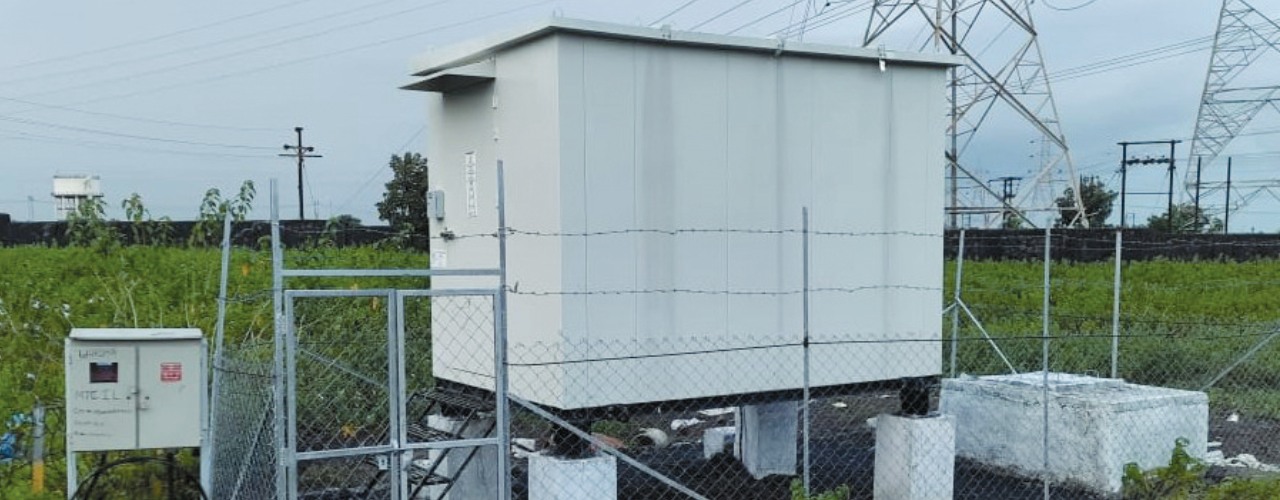Gurgaon Palwal Transmission Limited:
India's first Vertical Substation
Haryana is a growing economic and commercial powerhouse for the country and home to thousands of industrial and commercial establishments. To meet the peak energy requirements of Haryana, which is expected to grow from 9,000 MW in FY 2014-15 to more than 12,000 MW in FY 2020- 21. Today, the state meets its power deficit though high-capacity Diesel Generation (DG) sets, which are also a source of high pollution levels in the region. The Gurgaon-Palwal Transmission Limited (GPTL) was envisaged as part of an Interstate Transmission System project, to evacuate ~2,000 MW to Haryana Vidyut Prasaran Nigam Ltd. (HVPNL) ensuring access to reliable power for the people of Gurugram and Palwal – areas in the state.

THE CHALLENGES
The power demand in Haryana in likely to increase significantly in the coming years. This is primarily due to factors like rise in agricultural consumption, enhanced demand of existing consumers because of growing use of appliances, commercial activities and industriaisation, among others. To meet the peak load of 12,112 MW, a robust Interstate Transmission System (ISTS) was planned in the form of GPTL.
With increasing urbanisation, there is a scarcity of land available globally for constructing transmission assets. GPTL is also the first project for Sterlite Power which was constructed in a completely urban milieu. All the eleven elements in the project traversed through densely populated areas of Gurugram and Palwal areas. Thus, securing the RoW for the project had been a significant challenge.
WHAT WE DID
It is also a unique project as it implemented one-of-its-kind innovation in the power sector with India’s first vertical GIS substations built at Prithla, Kadarpur and Sohna. These 400/220 kV GIS substations are multi-storied substations with a rooftop 220 kV open switchyard. A conventional GIS substation of similar capacity generally requires 12 acres of land, but this innovative solution is built only on 3.8 acres resulting in 75% reduction in land size. Apart from the vertical substations, Multi Circuit Monopole towers have been built to optimise the space challenges related to the project. Apart from saving land, all these innovations have resulted in offsetting more than 18,000 tonnes of CO2 emissions each year as compared to a conventional layout for a similar GIS substation.
Achievements
The project not only evacuates ~2000 MW of reliable power to ~3 Million households in the state but will also brings cleaner air to NCR by reducing the use of diesel fired generator sets.
~3 Million households in the state benefitted
~2000 MW of power supply to Gurgaon and Palwal areas in Haryana
Reliable power supply to replace more than 10,000 DG sets in Gurugram
Project Ganga: Excellence in Project Execution and
Product Innovation
This project truly tested our mettle and challenged us to push our boundaries, resulting in unique process execution and significant product innovation that will change the way transmission lines are built across long-span river crossings and hilly terrains. We specially develop a customised solution—the ACCC ULS Ganga—which which was successfully strung across one of the longest spans on a river crossing, near Lakhisarai, to restore the disrupted 400kV Purnia – Biharshariff (PB) transmission line.


THE CHALLENGES
Difficult site conditions that required multiple mobilisations, climate change and frequently changing course of the Ganga River were hampering restoration efforts of the PB line. With towers washed away in a previous instance, there were no support structures in the middle of the river. Laying pile foundation would have been expensive, difficult and time consuming. It would have also disturbed the delicate ecosystem in the river and affected livelihoods of locals who were dependent on the river for survival. To implement our long-span solution, man, machine and material had to be moved on barges and ferries. Work was undertaken on floating platforms. Wind speeds were a critical factor and work had to be stopped frequently with winds blowing close to 30 miles per hour.
WHAT WE DID
We restored the PB transmission line that was pending for almost 2 years, utilising unique process and product innovation. The use of long-span stringing avoided the cost of drilling expensive pile foundations and saved the ecosystem in the riverbed from any major disruption. The solution developed for this project can be adapted for other long span transmission lines over river crossings and hilly terrains across the country.
Achievements
Sterlite Power’s ingenuity resulted in a unique process of stringing and a solution with the development of a carbon composite core ultra-low sag conductor –‘ACCC ULS Ganga’. Even the hardware accessories and tools were specially designed for this project. The new conductor addressed the main concern of keeping the sag low during stringing, while transferring the same power capacity.
Vineyards: Use of Aerial Technology to
Power Brazilian Grid
In 2010, the Brazilian Government's Energy Planning studies pointed out the need for structural works to follow the growth of the market in the State of Rio Grande do Sul. In 2017, Sterlite Power was chosen to build its second project in Brazil - the Vineyards.

THE CHALLENGES
One of the main challenges of the Vineyards project was crossing of the Taquari River, 368 meters wide, in an area of environmental protection.
For the execution of this crossing it was necessary to execute special foundations, supply of transmission towers 33 meters high with high foundations to support the floods of the river.
WHAT WE DID
The crossing was carried out using drones to carry a guide cable that later pulled the conductor cables.
For the exception of the crossing it was necessary to acquire the approval of the Brazilian Navy, which accompanied all activities.
Achievements
The Vineyards project was our second project in Brazil and Element 1 was delivered 31 months before the regulatory date and generated more than 500 direct and indirect jobs.
The project was a pioneer for us, with the use of cable launch techniques via drone, which allowed the effective reduction in launch time, operation costs, environmental and mainly in the mitigation of accident risks.
SkyrobTM: Making OPGW Stringing Safe
SkyrobTM is a first-of-its-kind semi-autonomous robot in India, developed by Sterlite Power to ensure safety of 'high-risk' operations of installation, inspection and maintenance of OPGW under 'live-line' conditions.

THE CHALLENGES
The power scenario in the country is expanding in leaps and bounds. As greater number of powerlines are installed, more maintenance and repair work will be required at shorter time durations. Moreover, out of the total 4,98,651 km of total EHV lines throughout India, as much as 50% is yet to be fiberised. The fiberisation of the remaining lines is critical for the Digital India vision to come true. A broadly practiced conventional method of OPGW installation is called ‘Cradle block method’ – the methodology of using traction machine for the installation.
However, the conventional methods come with quite a few limitations. A study shows that between 17 to 23 workers employed in the construction of EHV systems die over a working lifetime of 45 years. With SkyrobTM, Sterlite Power primarily aims at eliminating human and asset risk by almost 100%.
WHAT WE DID
Sterlite Power developed SkyrobTM – a semi-autonomous robot ensures safety of ‘high-risk’ operations involved in the installation, inspection and maintenance of OPGW on high-voltage power transmission lines under ‘live-line’ (energised-without shutting down the power lines) conditions.
SkyrobTM demonstrates the application of high-end robotics in the power transmission sector for the first time in India. Apart from ensuring safety, it helps in saving time and ensures high-quality project delivery for our customers. It performs visual inspection and health monitoring of existing wires and conductors of the transmission line. This indigenously developed robot helps in installing OPGW on overhead transmission lines in an efficient and timely manner.
Achievements
Safety: With SkyrobTM, Sterlite Power directly eliminates human and asset risk by almost 100%.
Efficiency: The improved efficiency of SkyrobTM also enables us to address the coinciding challenges of time, space and capital for our customers. With this innovation, we have been able to reduce project timelines by ~25%. In addition, the automation brought in by the innovation has enabled us in reduction of mobilisation of manpower by ~50%. Conventionally, OPGW stringing task required a team of 30 skilled labourers and 1 engineer. With SkyrobTM, we can now accomplish the same task with only 15 skilled labourers and an engineer. The innovation also reduces cost of upgradation.
Automation: The increased automation brought in by SkyrobTM has decreased human intervention and created a safer work environment. This, in turn, has a positive impact on the workmen in field.
Ease of working: With 50% lower dead weight and higher traction vis-à-vis conventional traction machine, this technology has made operation of the tool easier. With SkyrobTM, OPGW stringing has become a seamless activity.
Containerised Data Center (CDC):
Quicker Turnaround and Superior Customer Experience
With the ever-increasing data demand in India, Telcos need to upgrade to a reliable fibre infrastructure backbone which accompanies solid edge data center facilities. In a bid to improve response time and uplift the overall customer experience, Sterlite Power has brought a game-changing innovation in the execution strategy of the project. In one of the top Telco’s projects, we were entrusted with the task of building new colocation sites for hosting their telecom equipment in Mumbai-Kolhapur & Nagpur-Solapur belt.

THE CHALLENGES
Typically, colocation building exercise is done by developing the facility from scratch at the location itself. All the requisite materials are brought, the site is constructed, and equipment such as racks, cooling unit, surveillance, and remote monitoring system, etc. are installed. In addition to transportation and location challenges, individual installations employed in this method are time consuming.
WHAT WE DID
The unique solution implemented by Sterlite Power has the potential to standardise the process and ensure quality installation across all sites.
Post the completion of civil work, the containerised Edge Data Centers are shipped to the respective site locations using trailers and are placed at the site. A simple plugging into the power socket, and they are literally ready for the operation.
Such a unique concept of building modular edge data centers with tremendous benefits has set the trend.
Going ahead telecom colocation facilities will be made with Containerised Data Center solution.
Achievements
Implemented for the first time in the telecom industry, this model provides a scalable solution and improves quality standards. The fact, that all the installations and commissioning take place at the factory, addresses the time constraint. The solution also brings down the project cost, as it doesn’t have multiple stocking locations, has reduced traveling to sites, and avoids right of way (RoW) due to minimal action on the ground.
Such edge data centers, which are closer to the end consumers, boost network performance. Hence, delivering a better customer experience. Especially in remote tier 2 & 3 towns, where data demand has significantly improved thanks to the rise in OTT platforms and remote working.